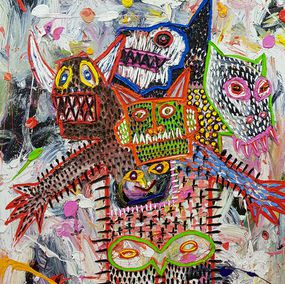Presentation
Born in 1993, he lives and works in Languedoc-Roussillon. David Djordjevic is a painter of battles. But these are intimate battles, in small groups. There are no more than one or two figures in each table. The war therefore takes place within a single character or between two who are together, who confront, oppose, tear each other apart. They are rather singular fights, duels, settling of scores. One could see in it psychological torment, parent-child, couple, mask-truth. We could see it as historical tragedy, torturer-martyred, dominant-victim. We could see in it divine aspiration, body-spirit, angel-demon. We could also see the solitary embrace of the artist who fights with his creation, who confronts and grabs it. Because David Djordjevic engages in a real clinch with painting. He confronts her physically and grabs her with his hands. It's not an image, Djordjevic paints with his fingers, straight out of the color tube. No brushes, no palette where the mixture is done. No middleman, restraint, negotiation, dosage. He goes there, thoroughly, squarely. His paintings are loaded, hard, strong, heavy, rich. They are embodied. They touch us because they have been touched. They abuse us because they have been bullied. Our eyes are too connected with the brain, with knowledge, with codes, with definitions. They are too saturated with words and images. Using his hands, David Djordjevic reconnects with prehistoric and early gestures. He finds the ritual, the cave, the den, the burrow, the nest, the refuge. And since he paints with his hands, does he paint with his eyes closed? Blindly ? Dazzled to have looked too much at the sun in the face? Or, like a dowser, does he sense presences under the surface? Are her hands pointing to things the eyes can't see? Skeletons are recurrent in his work. They are there, everywhere, as if it was obvious that each represented character walks the interior of his body for all to see. Does David Djordjevic perceive the structure of bones under clothing, under the skin, under the flesh? Are his hands good for fluoroscopy? In addition, the pelvic bones draw a strange shape, like a mask, with the two slits of the eyes and the tip of the nose, a sort of carnival evening wolf. There is a hidden meaning here. Sexual? In the vocabulary of manga, fantasy, heroic fantasy, legendary epic, the bones of the skeleton are sometimes figured on the battle dress. They are part of the panoply. It's a shamanic game with fear, with the afterlife, the dark side, the kingdom of shadows… See the feast of the dead in Mexico… and, closer to us, that of Halloween, popular and commercial success , inherited from a very old Celtic commemoration. Among the themes tackled by David Djordjevic, references to mythology are frequent. Myths are comics, spectacular films, which date back thousands of years, full of noise and fury, full of noise, instinctive forces, violent desires. For a young artist today, painting mythological scenes is certainly a way of talking about politics, the tragic, the sacred, and death. It is also a way of putting oneself, in all discretion, in the footsteps of the tradition of great painting, classical and modern. Wild, free, spontaneous, Djordjevic's works are a hymn to innocence, to jubilation, to the pleasure of putting colored paste on linen. They are drunk with thicknesses, colors, flavors, odors of oil. However, his approach is not without references. She is part of the angry, emotional family, of those who are in the abundance of matter, in the discharge of energy: the Russian Chaïm Soutine, the expressionist Germans, the Danes, Belgians, the Dutch of the Cobra group, the French Eugène Leroy and Paul Rebeyrolle, the American Jean-Michel Basquiat… As we can see, it is an international family. Djordjevic is self-taught. He did not follow an artistic education. He opens and traces himself the roads he follows, alone, inhabited by his quest and his passion. However, I would just like to point out, before closing, that his historic family lineage does not come from nothing. He was certainly born in Montpellier in 1993, but his Serbian origins loaded him with a heavy depth of torment and drama. You only have to see the paintings of Vladimir Velickovic, who was born in Belgrade in 1935, whose painting is marked with horrors and horrors, to feel what I am saying. Pierre Tilman.
Read more
All artworks of David Nicolas Djordjevic

No artworks by David Nicolas Djordjevic are currently available. To receive the latest information about their new pieces for sale, you can follow the artist or contact our Customer Service directly through the provided link.
Discover our selections of works by artists
Need help finding your favorite? Consult our selection pages made for you.
Need to know more?
When was David Nicolas Djordjevic born?
The year of birth of the artist is: 1993
